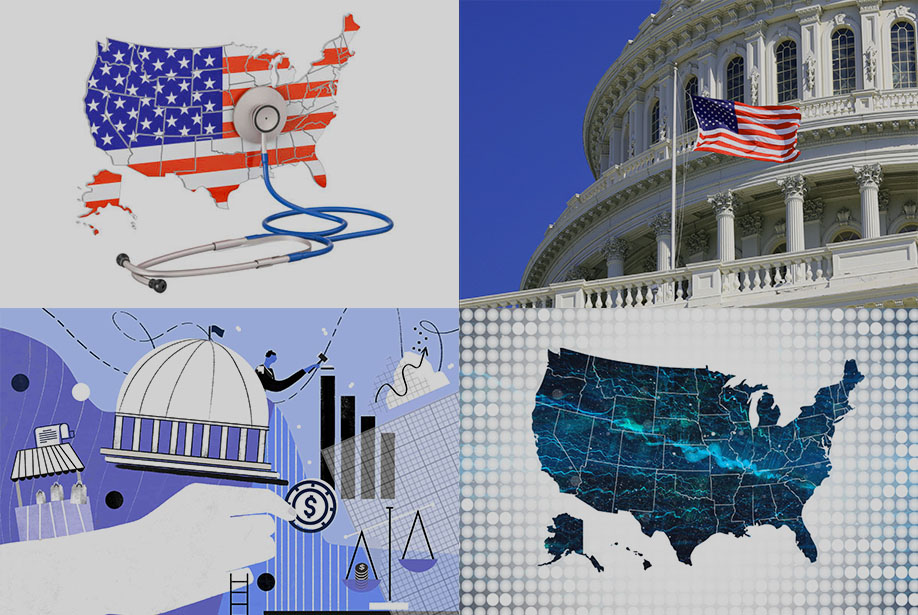From solar energy to the Internet and nuclear power to the iPhone, robust federal investments in R&D have been the most important part of effective innovation policy. Yet in clean energy, the U.S. invests far too little compared to other national priorities. And budget sequestration and Congressional gridlock are undercutting the potential to invest in a long-term energy innovation strategy.
The last century of breakthrough technology development also tells us that R&D, by itself, is not enough. Effective clean energy innovation policy also means supporting research and development through the valley-of-death, pilot-stage testing, first-of-kind demonstration, and smart deployment incentives that provide a temporary, early market for new technologies.
As a result, CCEI develops and advocates for federal policies that provide consistent and increased support, particularly for new clean technologies competing against entrenched fossil industries with a century worth of subsidy, regulatory, and infrastructure support.

Double number of Energy Frontier Research Centers. EFRCs are critical multi-disciplinary basic research teams working to solve fundamental energy problems in storage, materials, superconductivity, catalysis, nuclear, and efficient combustion. To accelerate solutions to the most nagging barriers to cheap clean energy, the number of EFRC’s should be doubled, requiring a budget of $300 million per year.
Increase fees and royalty rates on oil and gas drilling to fund ARPA-E. Congress should raise royalty rates on onshore leases as well as increase fees on unproductive acres for both onshore and offshore leases to raise at least $1 billion per year to fully fund ARPA-E.
Coordinate and create new program offices under a merged Secretary of Science and Technology. The new Secretary of Science and Technology should create new, broader program offices under the proposed Office of Science and Technology for better coordination of the entire spectrum of publically funded R&D. DOE and Congress should solicit comments from the research, industry, and academic communities to ensure that the new programs reflect the multidisciplinary nature of science and technology and integration between research and the marketplace.

Remove top-down overhead accounting rules at DOE National Labs. Congress should instruct DOE to remove prescriptive overhead accounting rules and instead provide broad categories of funding that the Labs can spend as necessary. This includes removing the cap on Lab Directed Research and Development (LDRD) funds and provide a description of technology transfer that allows Labs to spend overhead funds on early-stage demonstrations that either remove technology barriers limiting private-sector interest or repurpose original research for new problems.
Make permanent and expand DOE ACT agreements.DOE’s pilot program – Agreements for Commercializing Technology (ACT) – is a step towards freeing up the Labs ability to partner with industry more quickly and efficiently. As such, DOE or Congress should make ACT a permanent Lab-industry agreement as well as expand it to make industry partners that receive federal funding eligible.
Create a high-level task force for Lab effectiveness and accountability. The Office of Science and Technology (OSTP) should create a task force of DOE-Lab stakeholders to assess (1) ways DOE can devolve authority to the Labs and reduce red-tape; and (2) develop better technology transfer metrics and evaluation techniques to include in the Labs management and operations contract.
Transition to a DOE-Lab performance-based contractor accountability model. DOE should fully transition day-to-day management of Lab operations to the M&O contractors, where DOE would annually evaluate their success via an expanded and unified review process, based on the Office of Science’s PEMP process. This includes folding DOE Site Office oversight responsibilities as part of the negotiated M&O contract between DOE and Lab contractors. If it is agreed that decreased or no Site Office presences is needed, then DOE must act accordingly.
Award Labs autonomy in agreeing to Non-Federal Partnership Agreements. DOE should grant Labs the authority to implement a pilot program to allow Lab managers to agree to cooperative agreements with third parties, such as universities and industry, using pre-approved contractual frameworks absent DOE preapproval.
Make technology transfer part of DOE Labs annual report card. DOE should create a new category called “Technology Impact” in the Labs annual report card from DOE, which would evaluate Labs on the market impact of technology. The exact weight of this category would vary from Lab to Lab and would be negotiated upfront in the M&O contract depending on the degree of market applicability of each Lab’s research portfolio.
Execute consistent guidelines on conflict-of-interest. DOE should issues new, consistent guidance to the Labs encouraging research and management teams to partner with companies and entrepreneurs so that each Lab does not interpret conflict-of-interest laws differently, allowing for even and expanded entrepreneurial leave and exchange opportunities which directly impacts transferring Lab R&D from the lab bench to the market.
Allow the National Labs to take an equity stake in start-ups. A significant barrier to the National Labs partnering with industry is that start-ups often cannot bear the costs of doing so, even if modest Lab interaction would greatly accelerate innovation. Congress should make it easier for start-ups to leverage the National Labs by allowing the Labs to take an equity stake in the start-up in exchange for the start-up utilizing Lab infrastructure. Start-ups gain almost priceless access to Lab capabilities, while the Labs could potentially receive royalties if the Labs succeed, with little risk to the taxpayers.
Create a solar “SEMATECH” to coordinate solar RD&D and market barriers. Using existing budget authorities, DOE should seed a solar industry-led consortium modeled after SEMATECH to coordinate technology roadmaps, industry R&D, and standardized solutions for market deployment barriers to accelerate the development and smart deployment of next-generation solar.
Support a “BatteryShot” Initiative modeled after DOE’s SunShot Initiative. BatteryShot could coordinate government battery RD&D with the goal of producing a battery with a total system cost of less than $250/kWh and a range of at least 300 miles per charge.
Increase government procurement budgets explicitly for next-generation clean energy. Congress should authorize the Department of Defense and the General Services Administration a larger procurement budget to purchase emerging clean energy and energy efficiency technologies that meet the government’s mission and infrastructure needs, including electric vehicles and next-generation ICT.
Fully fund regional innovation programs at the DOC and DOE. The creation of regional clusters signifies a healthy and active innovation ecosystem. One only needs to look at Silicon Valley as a chief example. Clusters concentrate R&D, supply chains, talent, and infrastructure in a close geographic location, which drastically removes barriers to innovation, incentives collaboration, and acts as a venue for smart deployment. Through the Stimulus, the Departments of Commerce and Energy supported the creation of almost two-dozen regional clusters for clean energy. Yet, cluster support requires a more stable and well-funded clusters program at DOC and DOE.
Increase support for NSF’s ERC’s and I/UCRCs. Industry-university partnerships accelerate R&D from the lab to the market and clean energy R&D is no different. NSR operates two high-impact programs – Engineering Research Center’s and Industry-University Cooperative Research Centers that seed university-managed, industry-driven collaborative R&D centers. Yet each program is small, limiting the number of Centers that can be created. Congress should greatly increase ERC’s budget to $110 million and I/UCRC’s to $50 million per year, while also requiring each to attract higher industry buy-in to facilitate higher impact university-industry partnerships.
Fully Support a National Network for Manufacturing Innovation. Unlike leading manufacturing nations such as Germany, the U.S. lacks an integrated, well-funded network of large-scale, industry-led manufacturing innovation centers that accelerate technology deployment, demonstrate new technologies, perform applied R&D on new manufacturing processes and support education and training. The White House has already directed resources towards the creation of three NNMI’s, one being in power electronics related to energy. Congress should build on these early investments and expand the initiative to $500 million to allow for the creation of 15-20 additional centers.
Make process R&D eligible for the R&D Tax Credit.Process R&D is inherently important to energy firms scaling up manufacturing operations. Under the current R&D tax credit, the Treasury Department narrowly interprets the statute, making it difficult for firms to take the credit against process R&D. Congress should clearly state process R&D is eligible under the credit.
Offer planning grants for regions that want to create next-gen STEM schools. The emergence of regional clean energy clusters offers the opportunity to connect new STEM institutions to provide a ready talent-pool for clean tech companies and start-ups. To do so, Congress should allocate $10 million for the NSF Transforming Institution Grants program – in partnership with DOC and DOE – to offer planning grants for regional clusters looking to create new kinds of STEM high schools of universities to benefit their energy innovation ecosystem.